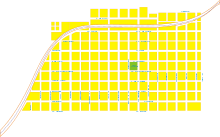Santa Rosa, La Pampa
Santa Rosa (Spanish pronunciation: [ˈsanta ˈrosa]) is a city in the Argentine Pampas, and the capital of La Pampa Province, Argentina. It lies on the east of the province, on the shore of the Don Tomás Lagoon, at the intersection of National Routes 5 and 35. The city (94,340) and its surroundings hold 102,610 inhabitants (2001 census [INDEC]),Census-ar 2.010 hold 124.101 inhabitants the capital y Toay around a third of the population of the province. Its current mayor is Leandro Altolaguirre. Founded in 1892 by Tomás Mason, Santa Rosa did not develop into a relatively important agricultural centre until the second half of the 20th century. It is still one of the smallest provincial capitals of the country after Patagonian Rawson, Ushuaia and Viedma.
Santa Rosa | |
|---|---|
City | |
 Coat of arms | |
%2C_departments_and_capital.png) | |
 Santa Rosa Location of La Pampa in Argentina | |
| Coordinates: 36°37′0″S 64°17′0″W | |
| Country | |
| Province | |
| Department | Capital |
| Founded | 22 April 1892 |
| Government | |
| • Intendant | Leandro Altolaguirre |
| Area | |
| • City | 1,500 km2 (600 sq mi) |
| Elevation | 175 m (574 ft) |
| Population (2010 census) | |
| • Urban | 102,880 |
| Time zone | UTC−3 (ART) |
| Postal code | L6300 |
| Phone code | +54 2954 |
| Website | (in Spanish) www.santarosa.gov.ar |
City sights include the Fitte neighbourhood (1930), the monument to San Martín, the Palace of Justice, the Teatro Español Theatre (1908), the Provincial Art Museum (with paintings by Raúl Soldi, Antonio Berni, Quinquela Martín and other important Argentine painters) and the Provincial Natural History Museum.
The Santa Rosa Airport (IATA: RSA, ICAO: SAZR) is located 2 kilometres from Santa Rosa on Route 35, and serves regular flights to Buenos Aires.
Near Santa Rosa is the city of Toay, together both cities form the Gran Santa Rosa metropolitan area.
Geography

Santa Rosa was founded on the western edge of the Argentine Pampas, in the range of contact of two different natural environments: the end of the plain and the beginning of the land of the Pampas broken valley.
The town occupies part of a centripetal basin having their base in Don Tomás Lagoon, where to drain rainwater from the surrounding area. The floor area lies west of it, in hilly terrain where the highest elevations are in the east, with two small plateaus located 200 meters. This high turnover is also observed north, with heights up to 195 meters. From here the terrain descends to the west and south, with slopes that are steep in some areas, since more than 3%. The southwest sector is lower and less undulating area, descending to 167 masl.
Climate
Santa Rosa has a humid subtropical climate (Cfa, according to the Köppen climate classification, with Cwa influence), with warm to hot summers and chilly, dry winters. The highest temperature recorded was 45.7 °C (114 °F) on January 6, 1955 while the record low is −12.7 °C (9 °F) on June 13, 1967.[1]
| Climate data for Santa Rosa (1981–2010, extremes 1902–present) | |||||||||||||
|---|---|---|---|---|---|---|---|---|---|---|---|---|---|
| Month | Jan | Feb | Mar | Apr | May | Jun | Jul | Aug | Sep | Oct | Nov | Dec | Year |
| Record high °C (°F) | 45.7 (114.3) |
42.5 (108.5) |
39.7 (103.5) |
36.5 (97.7) |
31.8 (89.2) |
27.1 (80.8) |
27.8 (82.0) |
34.4 (93.9) |
35.2 (95.4) |
38.0 (100.4) |
39.9 (103.8) |
42.8 (109.0) |
45.7 (114.3) |
| Average high °C (°F) | 31.0 (87.8) |
29.8 (85.6) |
26.9 (80.4) |
22.4 (72.3) |
18.0 (64.4) |
14.7 (58.5) |
14.2 (57.6) |
17.2 (63.0) |
19.7 (67.5) |
23.1 (73.6) |
26.7 (80.1) |
29.8 (85.6) |
22.8 (73.0) |
| Daily mean °C (°F) | 23.6 (74.5) |
22.1 (71.8) |
19.5 (67.1) |
14.9 (58.8) |
11.0 (51.8) |
7.9 (46.2) |
7.2 (45.0) |
9.5 (49.1) |
12.1 (53.8) |
15.9 (60.6) |
19.4 (66.9) |
22.5 (72.5) |
15.5 (59.9) |
| Average low °C (°F) | 16.4 (61.5) |
15.1 (59.2) |
13.4 (56.1) |
9.2 (48.6) |
5.7 (42.3) |
3.0 (37.4) |
2.0 (35.6) |
3.4 (38.1) |
5.7 (42.3) |
9.2 (48.6) |
12.2 (54.0) |
15.1 (59.2) |
9.2 (48.6) |
| Record low °C (°F) | 0.9 (33.6) |
2.3 (36.1) |
−3.7 (25.3) |
−7.0 (19.4) |
−8.6 (16.5) |
−12.7 (9.1) |
−12.3 (9.9) |
−10.0 (14.0) |
−8.8 (16.2) |
−4.3 (24.3) |
−1.2 (29.8) |
2.0 (35.6) |
−12.7 (9.1) |
| Average precipitation mm (inches) | 94.6 (3.72) |
81.0 (3.19) |
102.3 (4.03) |
58.0 (2.28) |
32.9 (1.30) |
15.5 (0.61) |
21.5 (0.85) |
28.1 (1.11) |
50.9 (2.00) |
74.7 (2.94) |
81.7 (3.22) |
104.3 (4.11) |
745.5 (29.35) |
| Average precipitation days (≥ 0.1 mm) | 9.1 | 6.8 | 8.0 | 6.0 | 5.1 | 4.3 | 4.3 | 3.7 | 5.7 | 8.5 | 7.8 | 8.4 | 77.7 |
| Average relative humidity (%) | 58.6 | 62.6 | 69.6 | 72.1 | 75.4 | 75.9 | 72.7 | 64.8 | 63.0 | 62.1 | 57.6 | 55.4 | 65.8 |
| Mean monthly sunshine hours | 319.3 | 257.6 | 226.3 | 195.0 | 158.1 | 132.0 | 145.7 | 179.8 | 186.0 | 226.3 | 273.0 | 303.8 | 2,602.9 |
| Percent possible sunshine | 71 | 68 | 59 | 59 | 50 | 45 | 47 | 54 | 53 | 56 | 65 | 67 | 58 |
| Source 1: Servicio Meteorológico Nacional[2] | |||||||||||||
| Source 2: NOAA (sun 1961–1990)[3] Meteo Climat (record highs and lows),[1] Oficina de Riesgo Agropecuario (August record high and low only)[4] | |||||||||||||
Sport
The city is home to football team, Club Atlético Santa Rosa, Club Atlético All Boys and Club Atlético Belgrano.
 Church in Santa Rosa, Argentina.
Church in Santa Rosa, Argentina. Municipal Building, Santa Rosa, Argentina.
Municipal Building, Santa Rosa, Argentina.- Monument to José de San Martín, Santa Rosa.
References
- "Station Santa Rosa" (in French). Meteo Climat. Retrieved June 11, 2015.
- "Estadísticas Climatológicas Normales - período 1981-2010" (in Spanish). Servicio Meteorológico Nacional. Retrieved January 21, 2018.
- "Santa Rosa Aero Climate Normals 1961-1990". National Oceanic and Atmospheric Administration. Retrieved March 30, 2015.
- "Santa Rosa, La Pampa". Estadísticas meteorológicas decadiales (in Spanish). Oficina de Riesgo Agropecuario. Retrieved June 11, 2015.
External links
| Wikimedia Commons has media related to Santa Rosa, La Pampa. |
- Santa Rosa Municipality (Spanish)
- Department of Transportation
- Municipal information: Municipal Affairs Federal Institute (IFAM), Municipal Affairs Secretariat, Ministry of Interior, Argentina. (in Spanish)
- Tourism (English)